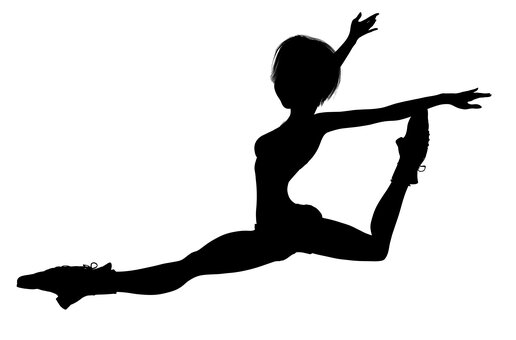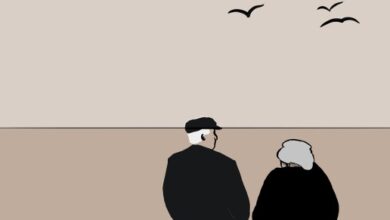
The Leap, written by Louise Erdrich and published in 1990, is a short story written in first-person narrative. The story revolves around the narrator’s now- blind mother, a former trapeze artist, to whom the narrator owes her life three times.
To read the story of The Leap, click here.
The Leap | Summary
The narrator begins by introducing her mother, Anna, as “the surviving half of a blindfold trapeze act”. Anna is now truly blind due to cataracts, and navigates the house with a gentle grace. The narrator almost forgets that her mother used to be a trapeze artist, for she does not talk about it at all, and preserves no memory from the time. The narrator feels that she is almost in debt because she owes her existence to her mother- Anna has saved her life three times.
The first was back when Anna was still performing in the circus. She was part of a duo with her then-husband, Harry, and they were called the Flying Avalons. However, during one show, a stroke of lightning during an unexpected storm hit the tent. Anna was pregnant at that time. She could have reached out and grabbed Harry’s ankle- with equal chance of saving him and falling alongside him to death- but instead, she chose to rescue herself in hopes of keeping the unborn baby safe. She escaped with injuries, while Harry died. Despite her efforts, the baby was born as a stillborn 2 months later, buried just beyond the house. The narrator considers this her mother’s first time saving her life– for if Anna had not saved herself, the narrator could not have been born. Anna’s self-preservation was a stepping stone into the narrator’s existence.
The second incident was the meeting between the narrator’s mother and father. The narrator’s father, who had passed away recently, was the doctor who nursed Anna back to health after the injury. He taught her to read and write, and when she wanted to continue living in the same place so as not to be separated from the tombstone of her unborn child, he agreed, moving them into his family’s farmhouse. This is the second debt- the hospital that brought about their union, and subsequently birthed the narrator.
The third incident that put the narrator in her mother’s debt was a direct one- Anna saved her daughter from a fire. The narrator was seven, and the babysitter ran out of the house to save herself. The narrator rolled a rug and kept it by the gap beneath the door, and wore her flannel robe as she had learnt in school, waiting for her parents. When her parents arrived at the scene with the firefighters, Anna knew the only way to save her was through a flimsy branch next to the window. Anna then took matters into her own hands, stripping down to her underwear and scaling the tree. The narrator remembers feeling relieved and embarrassed as she held onto her mother and escaped through a window. Her mother jumped down from the house and towards the firefighter’s safety net. As they fell, the narrator realised that there truly is time to think while falling. For a moment, she was worried about whether they would survive, but as she heard the beat of her mother’s heart, her fears were quelled.
The Leap | Analysis
Louise Erdrich writes in a simple, sentimental tone. The Leap presents a perfect balance of personal emotion and crisp recollection. Further, the chronological structure provides a clear format that helps the reader vividly picture Anna’s life. The overall mood of the piece is relatively somber because of the various difficulties faced, especially by the narrator’s mother. However, Erdrich skillfully interweaves an element of hope and optimism that outlasts the solemnity– she does this by subtle references to the mother’s strong and gentle attitude, as well as the intimate reassurance of the closing line. The narrator remains unnamed, which is a clever way of directing the attention of the story to the mother, despite the piece being in first-person. Though there are inserts of the narrator’s thoughts and feelings, the mother remains the main character. The themes of this piece are motherly love, overcoming difficulties, and chances of fate. The title The Leap is especially suitable because the story employs ‘leaping’ in both literal and metaphorical senses.
The paragraphs of the stare split evenly. The first one is an introduction to the narrator’s mother:
“My mother is the surviving half of a blindfold trapeze act, not a fact I think about much even now that she is sightless, the result of encroaching and stubborn cataracts.”
This line immediately creates a slight irony– the woman who performed blindfolded ended up becoming blind. It also creates a parallel between the art of leaping and the real-life happenings of Anna Avalon, which will be followed throughout the story. The narrator mentions that her mother “has kept no sequined costume, no photographs, no feathers or posters from that part of her youth.” This symbolises the wish to move on.
Certain things cannot be forgotten, but the tragedy that was borne from the mother’s trapeze act may result in her wish not to preserve its memory. It is interesting to note that despite not preserving any physical memorabilia, it is impossible to remove the characteristics of a flying performer from one’s physicality. The mother is described to be “catlike” and “precise”, moving smoothly even in her blindness- these qualities come from years of being a trapeze performer. This represents the impact that past situations have, even after time has passed and life has moved on. The narrator mentions that she almost forgets her mother’s past, but remembers when she “hears the crackle, catch a whiff of smoke from the stove downstairs.” This is in reference to her mother using her trapeze skills to save her from a fire when she was seven.
Anna’s trapeze accident took place because of unexpected lightning. It is key to note that the first instance and the last instance were both influenced by nature– in the former, lightning, and in the latter, fire. This may symbolise the power nature has over a human life. Fascinatingly, on the day of the accident, “There was time, before the storm, for three acts.” This is a parallel between leaping and real life- there were also three instances where the narrator felt that she owed her mother her life, just like how there were three acts before the storm hit the circus. We also see the theme of motherly love here- Anna chose to save herself in hopes of keeping the unborn baby alive. In paragraph five, the nature of the Flying Avalon’s show was described to be flirtatious and extraordinary. This playfulness may symbolise youth, and the accident represents its end- it is after this that Anna truly entered a difficult period, the stormy path from a carefree, love-filled youth to adulthood.
The narrator says “My mother once said that I’d be amazed at how many things a person can do within the act of falling.” This becomes important later on in the story. It refers to thinking both during a literal leap, as well as a leap of faith.
“Harry Avalon had wanted to be buried in the circus cemetery next to the original Avalon, his uncle, so she sent him back with his brothers.”
The fact that her ex-husband was not buried near her, but rather taken away, is a parallel to Anna’s need to move on. The narrator also mentions how she visits the unborn baby girl’s tombstone and considers her an “unfinished version of me.” This is our first hint that the narrator is a girl. It also dabbles in themes of egocentrism, mentioned in the story as well. It is this same childish thought process that contributed to the narrator feeling embarrassed when her mother came to save her, because she was only in her underwear. This childlike quality symbolises innocence.
During the second instance, when the narrator’s parents met in the hospital, the father taught Anna to read, and soon she was always seen with a book. We may note here that while her first passion- the trapeze act- involved her being blindfolded, reading is something that specially requires vision. This can be linked to Anna ‘opening her eyes,’ removing the blindfold and entering a new life. The narrator described it as “one form of flying for another.”- the real-life flying versus the flying of the mind in different universes. The inability to read was the greatest difficulty of Anna’s blindness. After the father’s death, the narrator continues to read aloud to her. We may wonder whether this action- enabling Anna to ‘fly’ once more– is the narrator’s way of ‘paying off the debt’ that she believes she owes her mother.
In the third instance, when the house starts to burn down with the seven-year-old narrator inside it, it is almost a replication of the lightning that struck the circus tent. The ladder breaks the same way the pole did. This may have been a treacherously full-circle moment for Anna, and more importantly, a chance to save the daughter she had not been able to save the first time. Once again, the theme of motherly love comes into play- Anna was willing to risk her life for the chance to save the narrator. The branch that Anna leaps onto is thin and weak, symbolising the fragility of life. Further, Anna stripping her clothes in order to jump into the burning house may also symbolise her stripping away her fears and past memories in order to save her daughter.
“She tapped on the window. I remember how she did it, too. It was the friendliest tap, a bit tentative, as if she was afraid she had arrived too early at a friend’s house.”
The abovementioned line, along with the narrator’s own admission, represents the thinking that can happen during a leap. Here, rather than a physical leap, Anna shows a sense of calm and rationality during a leap of faith. When they jump from the window, the narrator worries about the possibilities of landing wrong- this is the thinking during a literal leap. It is in this portion of the story that we see the biggest connection between literal and metaphorical leaping, as well as between Anna’s real-life experiences and her trapeze jumps. This freeing leap from the window, away from the fire and with her daughter in her arms, symbolises Anna’s strength and courage, as well as the overcoming of her past trauma and tragedy. Most importantly, the narrator’s words: “I felt the brush of her lips and heard the beat of her heart in my ears, loud as thunder, long as the roll of drums.” shows that simply the closeness to her mother was able to calm her in such a terrifying situation, highlighting the strength and power of a mother’s protection and love.

